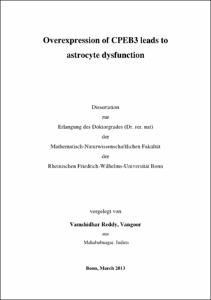Vangoor, Vamshidhar Reddy: Overexpression of CPEB3 leads to astrocyte dysfunction. - Bonn, 2013. - Dissertation, Rheinische Friedrich-Wilhelms-Universität Bonn.
Online-Ausgabe in bonndoc: https://nbn-resolving.org/urn:nbn:de:hbz:5n-32902
Online-Ausgabe in bonndoc: https://nbn-resolving.org/urn:nbn:de:hbz:5n-32902
@phdthesis{handle:20.500.11811/5722,
urn: https://nbn-resolving.org/urn:nbn:de:hbz:5n-32902,
author = {{Vamshidhar Reddy Vangoor}},
title = {Overexpression of CPEB3 leads to astrocyte dysfunction},
school = {Rheinische Friedrich-Wilhelms-Universität Bonn},
year = 2013,
month = jul,
note = {Cytoplasmic polyadenylation element binding (CPEB) proteins regulate the translation of mRNAs encoding key players involved in synaptic plasticity (Richter, 2007). CPEB1 in neurons is involved in synaptic plasticity (Alarcon et al., 2004), learning and memory (Berger-Sweeney et al., 2006). Several studies were focused on the role of CPEBs in neurons, but not much is known about the role of CPEB 2-4 subfamily in astrocytes. Hence the present study was aimed to investigate the expression of CPEBs in astrocytes and also to study the functional role of CPEB3 in astrocytes.
In the present work, the expression of CPEB (2-4) proteins in astrocytes was investigated. All CPEB transcripts and proteins were found to be expressed in astrocytes. CPEB3 was localized to the distal processes of astrocytes compared to the other CPEBs, similar to the localization observed in primary neuronal cultures. To study the functional role of CPEB3, transgenic mice were generated using the Tet-off system. Overexpression of CPEB3-EGFP in astrocytes during development caused enlarged ventricles, and acute overexpression in adult mice induced increased immunoreactivity for GFAP in cortex, hippocampus and thalamus, while in cells overexpressing CPEB3, GFAP protein content was decreased. In these brain areas, CPEB3 overexpression also led to downregulation of the protein levels for Cx43 and Cx30, two major astrocytic gap junction proteins involved in extracellular ion homeostasis and metabolite supply to neurons. Consistently, in the hippocampus of CPEB3 overexpressing mice, intercellular gap junction coupling was strongly impaired. Connexin function in RG-like cells is required for adult neurogenesis in the SGZ, a neurogenic niche in the hippocampus. In the SGZ of CPEB3 overexpressing mice, a significant reduction in the number of proliferating cells, reduced granule neurons and RG-like cells was observed. Altogether, the present study showed a negative correlation between CPEB3 expression and gap junctional coupling, which might be responsible for astrocyte heterogenity. All these results confirm that astrocytic connexins are CPEB3 targets. CPEB3 overexpression also led to downregulation of GLT-1 and GS, key players involved in extracellular glutamate clearance. Since interastrocytic coupling and astrocytic GLT-1 and GS activities are downregulated in epilepsy patients presenting with hippocampal sclerosis, it can be hypothesised that upregulation of CPEBs in astrocytes may contribute to the pathogenesis of epilepsy.},
url = {https://hdl.handle.net/20.500.11811/5722}
}
urn: https://nbn-resolving.org/urn:nbn:de:hbz:5n-32902,
author = {{Vamshidhar Reddy Vangoor}},
title = {Overexpression of CPEB3 leads to astrocyte dysfunction},
school = {Rheinische Friedrich-Wilhelms-Universität Bonn},
year = 2013,
month = jul,
note = {Cytoplasmic polyadenylation element binding (CPEB) proteins regulate the translation of mRNAs encoding key players involved in synaptic plasticity (Richter, 2007). CPEB1 in neurons is involved in synaptic plasticity (Alarcon et al., 2004), learning and memory (Berger-Sweeney et al., 2006). Several studies were focused on the role of CPEBs in neurons, but not much is known about the role of CPEB 2-4 subfamily in astrocytes. Hence the present study was aimed to investigate the expression of CPEBs in astrocytes and also to study the functional role of CPEB3 in astrocytes.
In the present work, the expression of CPEB (2-4) proteins in astrocytes was investigated. All CPEB transcripts and proteins were found to be expressed in astrocytes. CPEB3 was localized to the distal processes of astrocytes compared to the other CPEBs, similar to the localization observed in primary neuronal cultures. To study the functional role of CPEB3, transgenic mice were generated using the Tet-off system. Overexpression of CPEB3-EGFP in astrocytes during development caused enlarged ventricles, and acute overexpression in adult mice induced increased immunoreactivity for GFAP in cortex, hippocampus and thalamus, while in cells overexpressing CPEB3, GFAP protein content was decreased. In these brain areas, CPEB3 overexpression also led to downregulation of the protein levels for Cx43 and Cx30, two major astrocytic gap junction proteins involved in extracellular ion homeostasis and metabolite supply to neurons. Consistently, in the hippocampus of CPEB3 overexpressing mice, intercellular gap junction coupling was strongly impaired. Connexin function in RG-like cells is required for adult neurogenesis in the SGZ, a neurogenic niche in the hippocampus. In the SGZ of CPEB3 overexpressing mice, a significant reduction in the number of proliferating cells, reduced granule neurons and RG-like cells was observed. Altogether, the present study showed a negative correlation between CPEB3 expression and gap junctional coupling, which might be responsible for astrocyte heterogenity. All these results confirm that astrocytic connexins are CPEB3 targets. CPEB3 overexpression also led to downregulation of GLT-1 and GS, key players involved in extracellular glutamate clearance. Since interastrocytic coupling and astrocytic GLT-1 and GS activities are downregulated in epilepsy patients presenting with hippocampal sclerosis, it can be hypothesised that upregulation of CPEBs in astrocytes may contribute to the pathogenesis of epilepsy.},
url = {https://hdl.handle.net/20.500.11811/5722}
}






